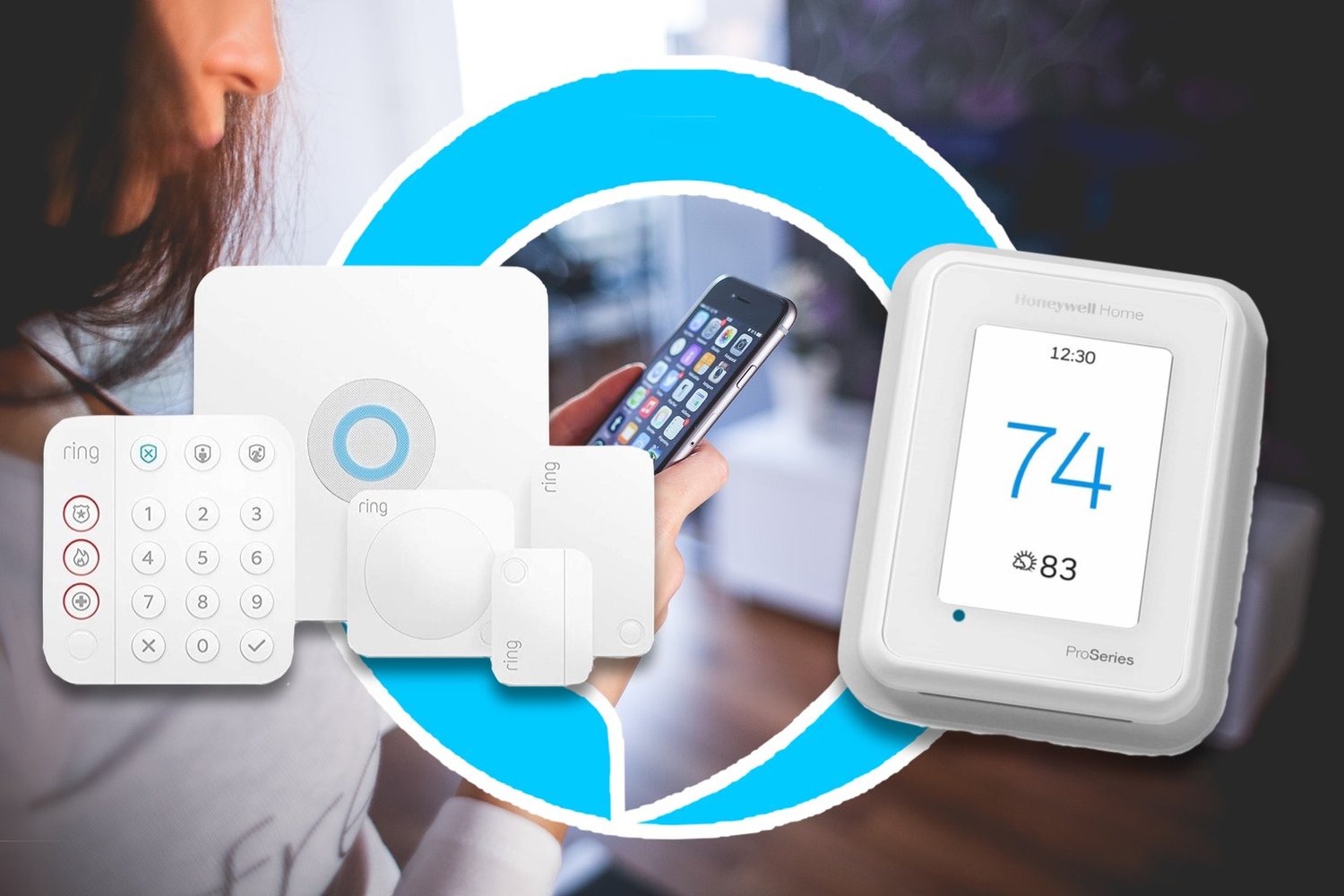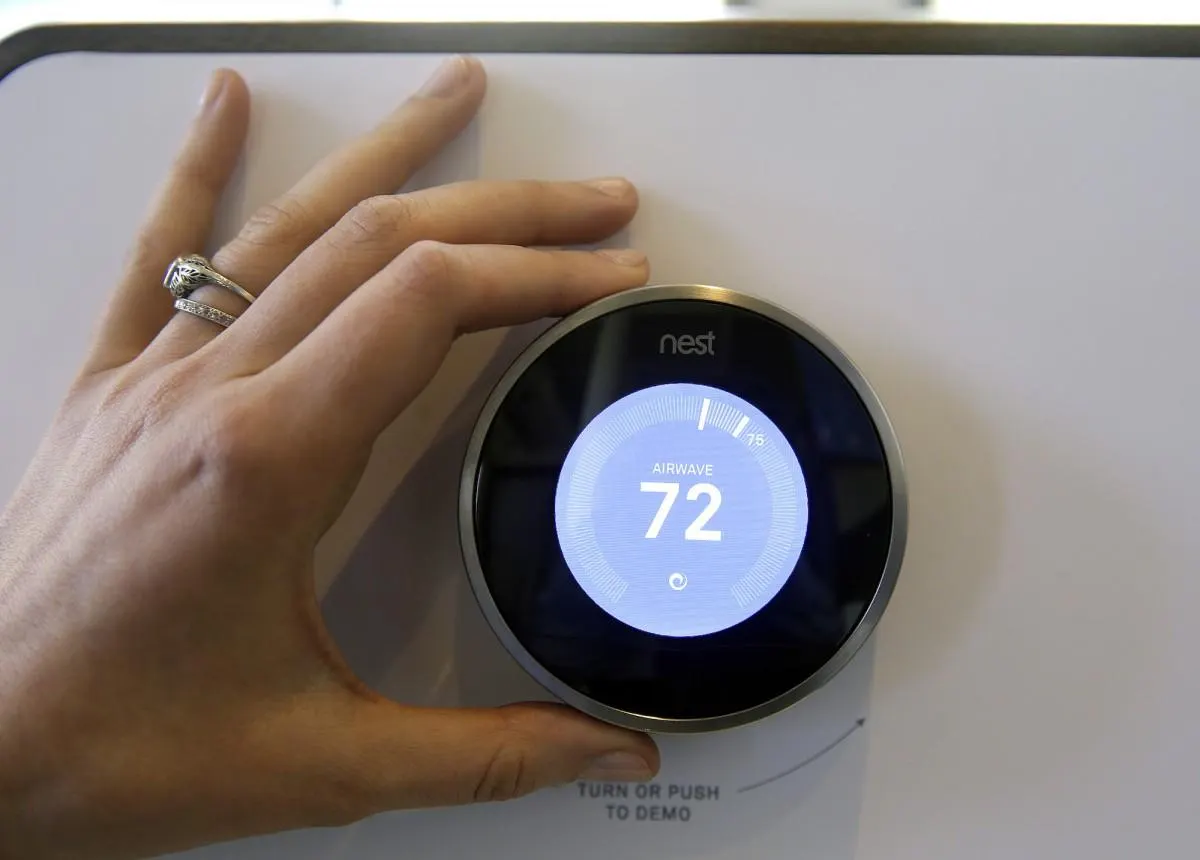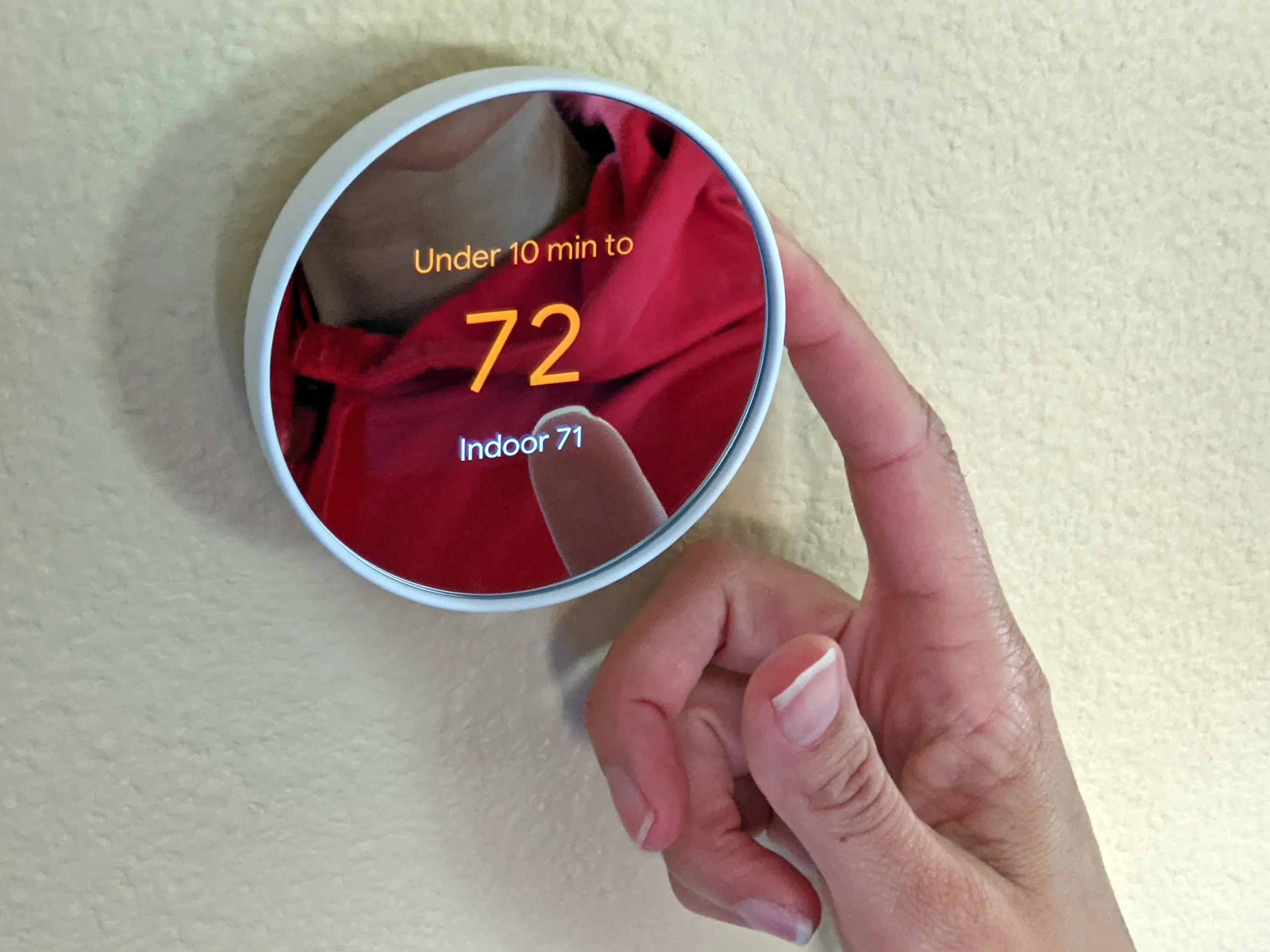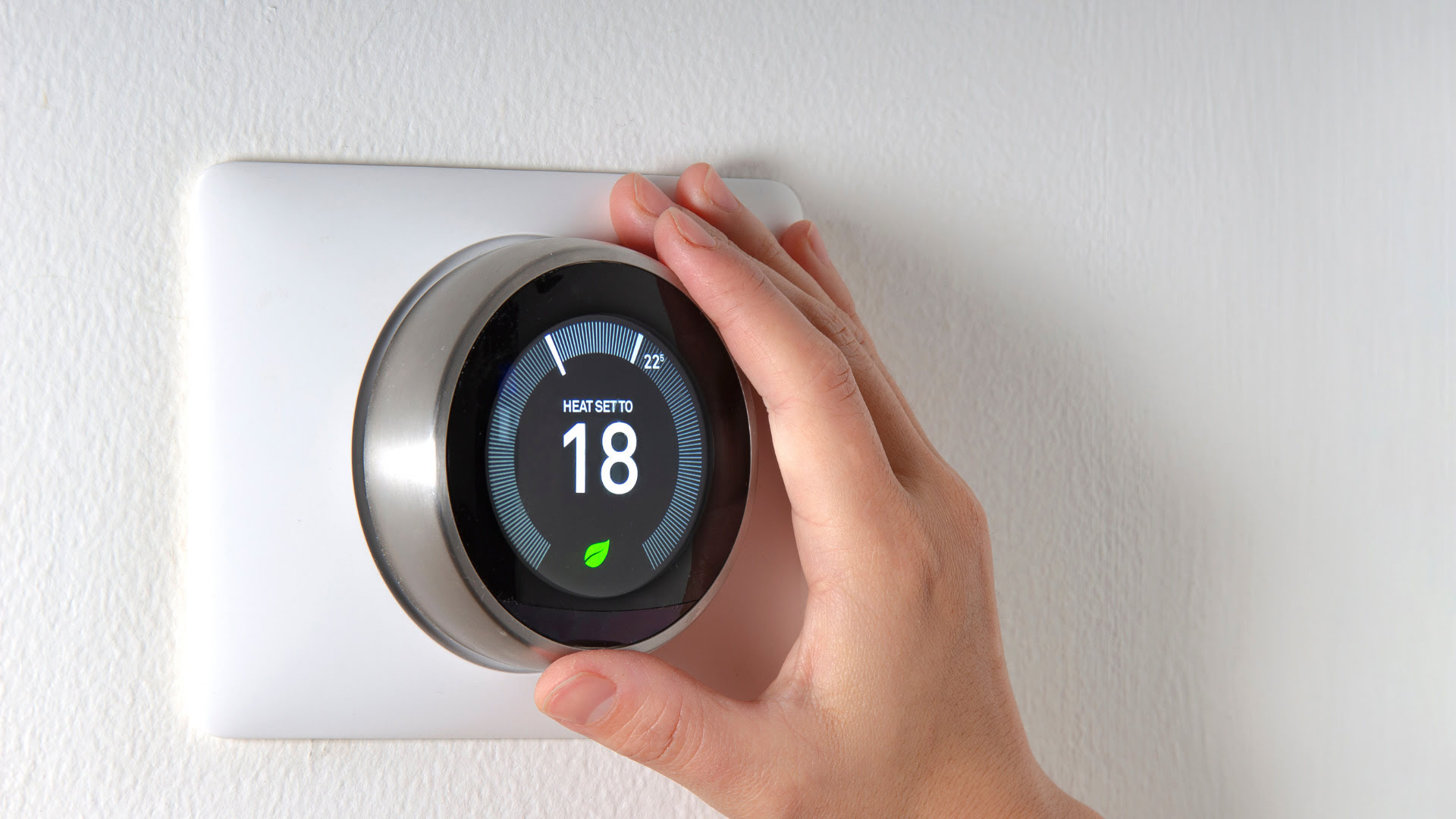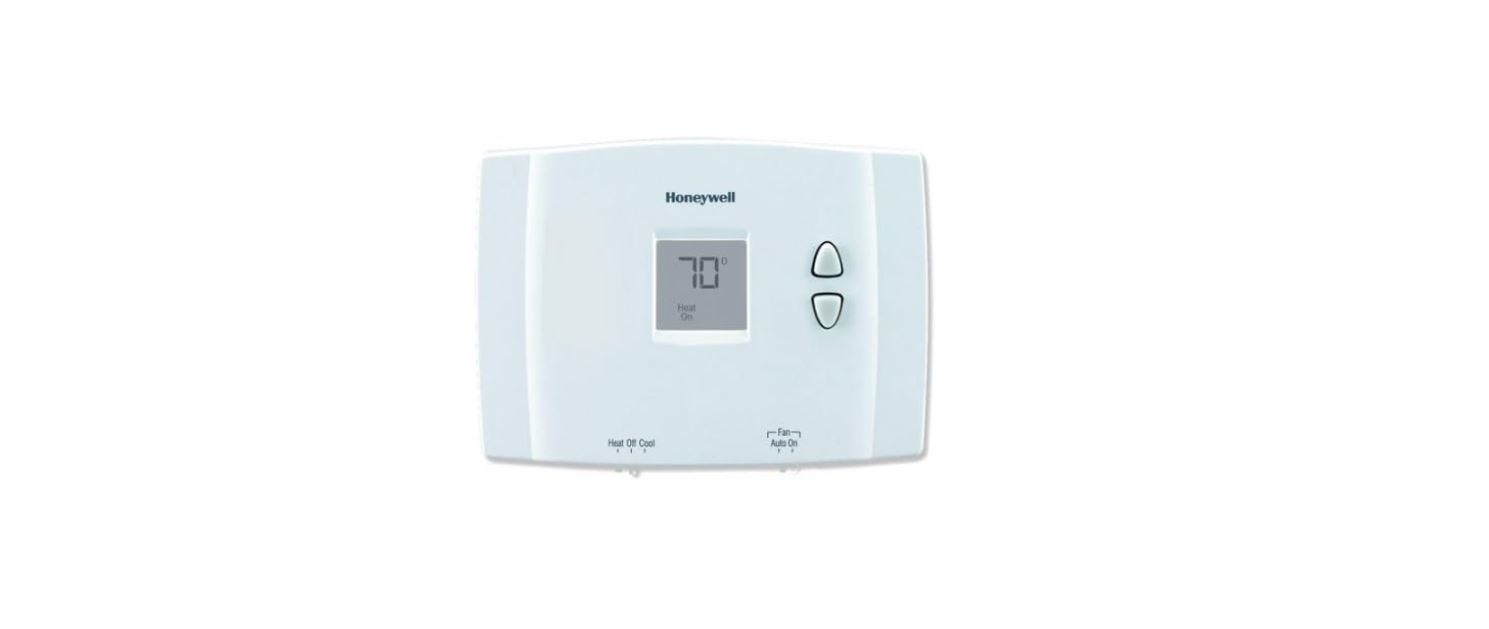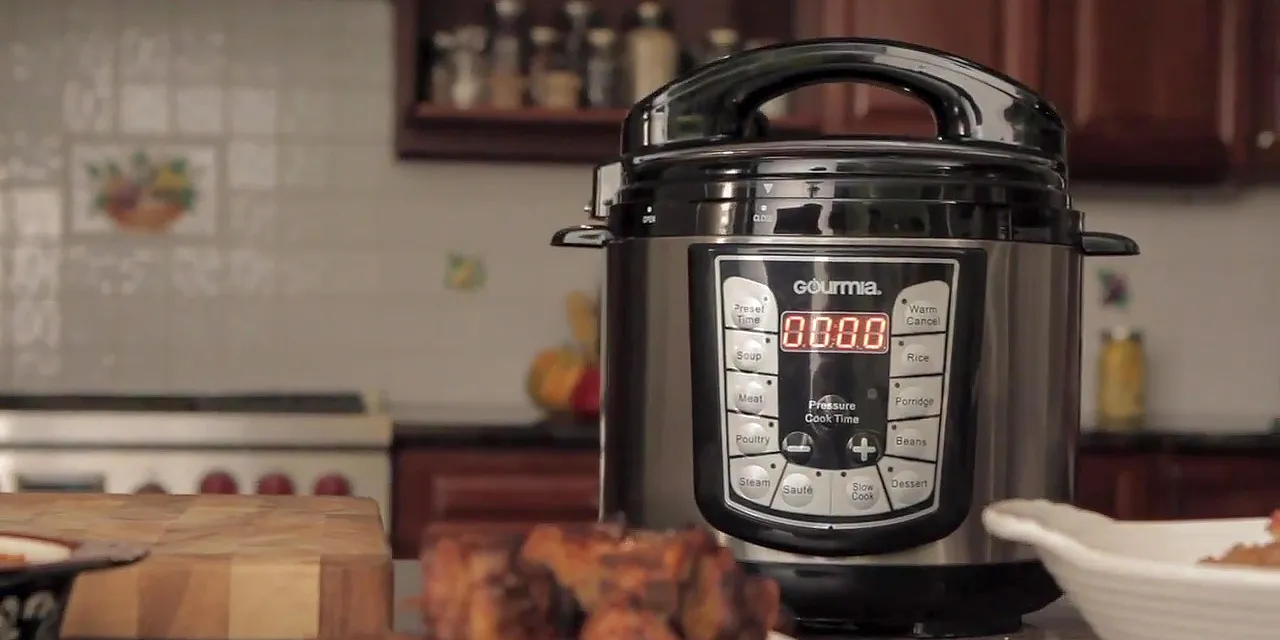Introduction
Welcome to our guide on thermostats that work with Ring! If you’re familiar with Ring, you may already know about their innovative home security products, such as video doorbells and security cameras. But did you know that Ring also offers integration with thermostats?
A thermostat is an essential component of any heating and cooling system in a home. It allows you to control the temperature, creating a comfortable environment and helping to reduce energy consumption. With Ring’s smart home technology, you can now connect and control your thermostat seamlessly through the Ring app.
Why would you want a thermostat that works with Ring, you might wonder? With this integration, you can have greater control over your home’s climate, even when you’re away. Imagine being able to adjust the temperature settings before you arrive home, ensuring a cozy environment when you step through the door. Or being able to tweak the thermostat settings remotely when unexpected weather changes occur.
In this guide, we will explore the benefits of having a thermostat that works with Ring, popular thermostat brands that are compatible with Ring, the installation process, and how to troubleshoot any potential issues that may arise during the integration process.
So, whether you’re a current Ring user looking to expand your smart home capabilities or someone considering Ring for the first time, this guide will provide you with the information you need to select the right thermostat and seamlessly integrate it with your Ring ecosystem.
What is Ring?
Ring is a company that specializes in home security and smart home technology. They are best known for their range of video doorbells and security cameras that allow homeowners to monitor and protect their property remotely. Founded in 2013, Ring quickly gained popularity for its innovative and user-friendly products.
One of the key features of Ring is its connectivity and integration with other smart home devices. Through the Ring app, users can control and manage not only their doorbells and cameras but also a wide range of compatible devices, including thermostats.
Ring offers a comprehensive smart home ecosystem, allowing users to easily connect and control their devices from a single platform. This integration goes beyond just security components and extends to everyday devices that enhance the comfort and convenience of your home.
With Ring, you can not only monitor your home’s security but also automate and customize functions such as lighting, locks, and now, even your thermostat. This seamless integration allows you to manage multiple aspects of your home’s systems with ease, providing a more streamlined and connected experience.
Ring’s mission is to make neighborhoods safer and homes more connected. The ability to connect a thermostat to the Ring ecosystem aligns with that mission by giving users greater control and access to their home’s climate. Whether you’re concerned about energy efficiency, want the convenience of adjusting your thermostat remotely, or simply want to create a comfortable living environment, integrating a thermostat with Ring can be a valuable addition to your smart home setup.
What is a thermostat?
A thermostat is a device used to control and regulate the temperature in a home or building. It is typically connected to a heating or cooling system and allows users to set the desired temperature, which the thermostat then maintains by signaling the system to turn on or off as needed.
Thermostats have come a long way from simple mechanical devices with a temperature dial. Today, most thermostats are digital and programmable, offering advanced features and functionality.
One of the main purposes of a thermostat is to provide comfort and energy efficiency. By accurately controlling the temperature, you can create a pleasant indoor environment that suits your preferences. During colder months, you can keep the temperature warm and cozy, while in hotter times, you can maintain a cool and refreshing atmosphere.
Energy efficiency is another key aspect of thermostats. Through proper temperature control and programming, you can optimize your energy usage and reduce heating and cooling costs. Programmable thermostats allow you to set different temperature settings for specific times of the day or week, ensuring that you’re not wasting energy when you’re not at home or during certain hours.
Thermostats also play a crucial role in maintaining a consistent temperature throughout your home. They monitor the current temperature and adjust the heating or cooling system to reach and maintain the desired setpoint. This not only ensures comfort but also prevents energy waste and prevents rapid temperature fluctuations.
With the advancement of technology, smart thermostats have emerged as a popular choice among homeowners. These thermostats can connect to Wi-Fi networks, allowing users to control them remotely through a smartphone app or integrate them with other smart home devices. Smart thermostats offer features such as learning capabilities, geofencing, and energy usage reports, providing even greater convenience and energy savings.
In summary, a thermostat is a device that controls and regulates the temperature in your home or building. It provides comfort, energy efficiency, and the ability to customize and optimize temperature settings according to your preferences and lifestyle.
Why would you want a thermostat that works with Ring?
Integrating a thermostat with Ring offers several advantages and can greatly enhance your overall smart home experience. Here are some compelling reasons why you might want a thermostat that works with Ring:
1. Centralized Control: With a thermostat that works with Ring, you can conveniently control your thermostat alongside other smart home devices through the Ring app. This centralized control lets you manage and monitor multiple aspects of your home’s systems from one place, creating a more streamlined and cohesive experience.
2. Remote Access: One of the most significant benefits of Ring integration is the ability to control your thermostat remotely. Whether you’re at work, on vacation, or simply lounging on the couch, you can easily adjust the temperature settings through the Ring app. This feature ensures that you always return to a comfortable home and allows you to make energy-saving adjustments even when you’re not physically present.
3. Energy Efficiency: By combining your thermostat with Ring, you gain access to energy reports and usage insights. These reports provide valuable data on your energy consumption patterns, helping you identify areas for improvement and make informed decisions to reduce energy waste. With the ability to monitor and adjust your thermostat’s settings remotely, you can ensure optimal energy efficiency and potentially save on heating and cooling costs.
4. Enhanced Security: Integrating your thermostat with Ring adds an extra layer of security to your home. Ring’s security features, such as motion detection and activity alerts, work in harmony with your thermostat to detect any unusual patterns or unexpected changes in temperature. This integration contributes to a comprehensive home security system, giving you peace of mind and protecting your home from potential risks.
5. Automation and Integration: With Ring’s automation capabilities, you can create customized routines and scenarios that link your thermostat with other smart devices. For example, you can program your thermostat to adjust the temperature when you disarm your Ring alarm system or have it sync with other devices based on your schedule or occupancy. This automation and seamless integration allow for a more efficient and comfortable living environment.
6. Compatibility and Expansion: Ring works with a wide range of thermostat brands, offering compatibility options to suit different needs and preferences. This flexibility means that you can choose a thermostat that aligns with your specific requirements and easily expand your smart home setup. Whether you’re looking for a basic programmable thermostat or a more advanced smart thermostat, there are options available that integrate smoothly with Ring.
By combining the features and benefits of a thermostat with the convenience and capabilities of Ring, you can elevate your home’s comfort, energy efficiency, and security while enjoying the enhanced control and automation offered by a comprehensive smart home ecosystem.
Benefits of having a thermostat that works with Ring
Having a thermostat that works with Ring can bring numerous advantages to your home and daily life. Here are some key benefits of integrating a thermostat with Ring:
1. Convenience: With a thermostat that works with Ring, you can control your home’s temperature from anywhere using the Ring app on your smartphone or other connected devices. This convenience allows you to adjust the temperature settings before you arrive home, ensuring a comfortable environment upon your arrival.
2. Energy Efficiency: Integrating your thermostat with Ring can help you save on energy costs and reduce your environmental footprint. With remote access and scheduling features, you can optimize your thermostat’s settings to align with your daily routine, automatically adjusting the temperature when you’re away or asleep. This energy-saving capability promotes greater efficiency and allows you to actively contribute to a greener lifestyle.
3. Enhanced Comfort: A thermostat that works with Ring enables you to create a more comfortable living environment. With precise temperature control and the ability to adjust settings remotely, you can ensure that your home is always at the optimal temperature. Whether it’s waking up to a cozy home in the winter or cooling it down during the summer, having control over your thermostat brings comfort at your fingertips.
4. Integration with Ring Security: Integrating your thermostat with Ring security devices can provide an added layer of safety and convenience. For example, you can set your thermostat to automatically adjust the temperature when you arm or disarm your Ring alarm system. This integration enhances your overall security system and creates a more seamless smart home experience.
5. Smart Home Automation: Ring’s ecosystem allows you to create automation routines and scenes that include your thermostat. By linking your thermostat with other smart devices, such as lights and cameras, you can create customized scenarios that enhance your daily routines. For instance, you can have your thermostat adjust the temperature when you enter or leave a room, ensuring energy efficiency and comfort.
6. Data Insights: Ring’s comprehensive smart home platform provides data insights and usage reports for your thermostat. These reports can give you valuable information about your energy consumption patterns, helping you make informed decisions on optimizing energy efficiency and reducing wasteful usage. By understanding your thermostat’s performance, you can take steps to improve comfort and lower your energy bills.
7. Compatibility and Expansion: Ring works with a wide range of thermostat brands, giving you the flexibility to choose the one that suits your needs and preferences. Whether you prefer a basic programmable thermostat or a more advanced smart thermostat, you can find a compatible option that seamlessly integrates with your Ring ecosystem. This compatibility also allows for easy expansion of your smart home setup in the future.
By combining the capabilities of a thermostat with the convenience and functionality of Ring, you can experience enhanced comfort, energy efficiency, and security in your home. The ability to control and manage your thermostat from anywhere empowers you to create your ideal living environment while promoting sustainability and energy savings.
Popular Thermostat Brands that are Compatible with Ring
When it comes to choosing a thermostat that works with Ring, you have several popular brands to consider. These brands offer a range of features, designs, and price points, giving you options to find the perfect thermostat for your home. Here are some of the top thermostat brands that are compatible with Ring:
1. Nest: Nest is known for its sleek and intuitive thermostats that offer energy-saving features and learning capabilities. Nest thermostats are compatible with Ring and can be seamlessly integrated into your Ring ecosystem. With features like auto-scheduling and motion detection, Nest thermostats provide efficient heating and cooling while adapting to your preferences.
2. Ecobee: Ecobee thermostats are another popular choice that works with Ring. These thermostats are known for their smart features, including room sensors that detect occupancy and adjust the temperature accordingly. Ecobee thermostats offer compatibility with Ring’s app, allowing you to control and monitor your home’s climate conveniently.
3. Honeywell: Honeywell is a trusted brand in the HVAC industry and offers a wide range of thermostats compatible with Ring. From basic programmable thermostats to more advanced smart thermostats, Honeywell provides options that suit different needs and budgets. With Ring integration, you can conveniently control your Honeywell thermostat alongside your other Ring devices.
4. Emerson Sensi: Emerson Sensi thermostats are known for their simplicity and ease of use. These thermostats offer Wi-Fi connectivity and the ability to control and monitor your home’s temperature through the Ring app. With features like geofencing and 7-day scheduling, Emerson Sensi thermostats deliver comfort and energy efficiency.
5. Carrier: Carrier is a well-established brand in the heating and cooling industry, and their thermostats are compatible with Ring. Carrier thermostats offer advanced features such as intelligent recovery and humidity control. With Ring integration, you can conveniently manage your Carrier thermostat from your smartphone and create a seamlessly connected smart home experience.
6. Rheem: Rheem is another reputable brand that offers compatible thermostats for Ring integration. Rheem thermostats provide precise temperature control and energy-saving features. With the ability to connect to Ring, you can control and monitor your Rheem thermostat remotely, optimizing comfort and energy efficiency.
These are just a few examples of popular thermostat brands that work with Ring. However, it’s important to note that Ring’s compatibility extends beyond these brands, and there may be other compatible options available in the market. Before making a purchase, ensure that the specific model you choose is listed as compatible with Ring to ensure seamless integration into your smart home ecosystem.
How to Choose the Right Thermostat for Your Home
When selecting a thermostat for your home that works with Ring, there are several key factors to consider. Taking these factors into account will help you choose the right thermostat that meets your specific needs and enhances your smart home experience. Here are some important considerations:
1. Compatibility: Ensure that the thermostat you choose is compatible with Ring. Check the manufacturer’s specifications or consult the Ring website to verify compatibility. This step is crucial to ensure seamless integration with your Ring ecosystem and the ability to control your thermostat through the Ring app.
2. Heating and Cooling System Compatibility: Check if the thermostat is compatible with your specific heating and cooling system. Some thermostats are designed for specific systems, such as conventional HVAC systems, heat pumps, or multi-zone systems. Make sure the thermostat you choose can effectively control your home’s heating and cooling system for optimal performance.
3. Features and Functionality: Consider the features and functionality you desire in a thermostat. Basic features include programmable schedules, temperature presets, and energy-saving modes. However, there are advanced options available with features like learning capabilities, room sensors, geofencing, and Wi-Fi connectivity. Determine which features are essential for your needs to find a thermostat that offers the right level of functionality.
4. Energy Efficiency: Look for energy-efficient models that can help you reduce energy consumption and lower your utility bills. Thermostats with energy-saving features, such as occupancy detection, adaptive scheduling, and usage reports, can assist in optimizing energy usage and promoting sustainability.
5. Ease of Use: Consider the user interface and ease of operation of the thermostat. Look for models with intuitive controls and clear displays that are easy to understand and navigate. Some thermostats also offer smartphone apps or voice control compatibility for added convenience.
6. Design Aesthetics: If the appearance of the thermostat is important to you, consider the design and aesthetics of the unit. Thermostats come in various styles and finishes, allowing you to choose one that blends well with your home’s décor.
7. Budget: Determine your budget range for a thermostat. Prices can vary based on brand, features, and smart capabilities. It’s essential to find a balance between your desired features and your budget to ensure you’re getting the most value for your investment.
8. Customer Reviews and Ratings: Before finalizing your decision, read customer reviews and ratings for the thermostats you’re considering. Reviews can provide valuable insights into the performance, reliability, and user experience of the thermostat, helping you make an informed decision.
By considering these factors, you can narrow down your options and find the right thermostat that not only works with Ring but also meets your specific requirements. Remember to prioritize compatibility, features, energy efficiency, ease of use, design, and budget to find the perfect thermostat for your home.
Installation Process for a Thermostat that Works with Ring
Installing a thermostat that works with Ring is a straightforward process that can usually be completed by following a few simple steps. While the specific installation instructions may vary depending on the brand and model of the thermostat, here is a general guide to help you through the installation process:
1. Preparation: Before beginning the installation, ensure that you have the necessary tools, such as a screwdriver and wire strippers. Familiarize yourself with the user manual or installation guide provided by the thermostat manufacturer. It’s also essential to turn off the power to your HVAC system at the circuit breaker to ensure safety.
2. Remove the Old Thermostat: Carefully remove the cover of your existing thermostat to expose the wiring. Take a clear picture of the wiring configuration or label the wires to ensure you reconnect them correctly later. Disconnect and remove the old thermostat from the wall, exposing the mounting plate.
3. Mount the New Thermostat: Depending on the model, mount the new thermostat’s baseplate to the wall using screws and anchors. Ensure it is securely attached and level. Thread the wires through the baseplate’s opening or use the wire access provided.
4. Connect the Wiring: Follow the manufacturer’s instructions or refer to the wiring diagram provided to connect the wires from your HVAC system to the corresponding terminals on the new thermostat baseplate. Typically, wires are connected by gently stripping their ends, inserting them into the appropriate terminals, and securing them.
5. Attach the Thermostat Cover: Place the thermostat cover over the baseplate and attach it securely using the provided screws or locking mechanism. Ensure that it is properly aligned and fits snugly onto the baseplate.
6. Power Up and Test: Turn the power supply back on at the circuit breaker to restore power to your HVAC system. Your new thermostat should power up and display initial setup instructions or prompts. Follow these instructions to set up your thermostat preferences, including connecting it to your home’s Wi-Fi network if applicable.
7. Pair with Ring: After successfully setting up your thermostat, follow the instructions provided by Ring to connect and pair it with your Ring app. This process typically involves linking the thermostat to your Ring account and granting the necessary permissions for integration.
8. Test and Customize: Once your thermostat is connected to Ring, test its functionality by adjusting the temperature settings through the Ring app or manually at the thermostat. Ensure that the Ring app displays the correct temperature and that you can control the thermostat remotely. Customize any additional settings or preferences specific to your desired comfort and energy-saving needs.
Remember to consult the manufacturer’s specific installation instructions and guidelines for your thermostat model to ensure a successful and proper installation. If you encounter any difficulties or are unsure of any steps, consider seeking professional assistance from a licensed HVAC technician.
How to Connect Your Thermostat to Ring
Connecting your thermostat to Ring is a straightforward process that allows you to control and monitor your thermostat through the Ring app. While the specific steps may differ slightly depending on your thermostat brand and model, here is a general guide to help you connect your thermostat to Ring:
1. Ensure Compatibility: Before you begin, verify that your thermostat is compatible with Ring. Check the manufacturer’s specifications or consult the Ring website to confirm compatibility.
2. Set Up Your Ring Account: If you haven’t already, create an account and set up your Ring devices. Download the Ring app on your smartphone or tablet and follow the instructions to add your Ring products to your account.
3. Access Thermostat Settings: Open the Ring app on your mobile device and navigate to the devices section. Find and select your thermostat to access its settings and configuration options.
4. Enable Integration: In the thermostat settings within the Ring app, look for an option to enable integration or connect your thermostat. Follow the prompts and instructions provided to begin the integration process.
5. Connect to Wi-Fi: If your thermostat requires a Wi-Fi connection, ensure that it is connected to your home’s Wi-Fi network. Follow the steps within the Ring app to connect your thermostat to Wi-Fi, if necessary.
6. Link Your Thermostat: Within the Ring app, you may be prompted to link your thermostat by entering your thermostat account credentials or providing additional information. Follow the on-screen instructions to complete this step.
7. Grant Permissions: To enable full functionality and communication between your thermostat and Ring, you may need to grant certain permissions or access rights. These permissions allow the Ring app to control and monitor your thermostat’s settings.
8. Test the Connection: Once the integration process is complete, test the connection by adjusting the thermostat settings through the Ring app. You should be able to control the temperature, change modes, and access other thermostat functions remotely through the app.
9. Customize and Set Preferences: Take some time to explore the settings and customization options offered by the Ring app for your thermostat. Set up temperature schedules, energy-saving preferences, and any other settings relevant to your needs and lifestyle.
Keep in mind that the specific steps may vary depending on your thermostat model and firmware version. If you encounter any difficulties during the connection process, refer to the manufacturer’s documentation or consider reaching out to their customer support for assistance.
By successfully connecting your thermostat to Ring, you can enjoy the convenience of controlling and monitoring your thermostat remotely through the Ring app. This integration allows for seamless management of your home’s climate, enhancing your overall smart home experience.
Troubleshooting Common Issues with Thermostats and Ring Integration
While integrating your thermostat with Ring can greatly enhance your smart home experience, it’s possible to encounter occasional issues or challenges along the way. Here are some common problems that may arise during the thermostat and Ring integration, along with troubleshooting steps to help you resolve them:
1. Connectivity Issues: If you’re experiencing difficulties connecting your thermostat to Ring, ensure that both devices are connected to the same Wi-Fi network. Verify that your internet connection is stable and try rebooting both your thermostat and Ring devices. If the problem persists, check for any firmware updates for both devices and install them if available.
2. Incorrect Temperature Reading: If your thermostat is displaying an incorrect temperature, first check that it is placed away from any heat sources or drafts that could affect its accuracy. Ensure that the thermostat’s temperature sensor is clean and free from any obstructions. Additionally, verify that the thermostat’s settings and schedule are properly configured to reflect your desired temperature settings.
3. Unresponsive Thermostat: If your thermostat is unresponsive, check if the batteries need to be replaced or if the power supply is interrupted. If your thermostat is wired, ensure that all wiring connections are secure and properly connected. If the issue persists, consult the manufacturer’s troubleshooting guide or contact their customer support for further assistance.
4. Wi-Fi Connection Problems: If your thermostat requires a Wi-Fi connection and you’re experiencing connectivity issues, check that your Wi-Fi network signal is strong and stable in the area where the thermostat is installed. Consider rebooting your router or repositioning it for better coverage. You can also try adjusting the settings or frequency band of your Wi-Fi network to optimize the connection.
5. Syncing and Scheduling Issues: If your thermostat is not syncing with the Ring app or if the scheduled temperature changes are not taking effect, ensure that you have granted the appropriate permissions within the Ring app for thermostat control and monitoring. Double-check that your schedule settings are accurate and saved correctly. Try removing and re-adding the thermostat to the Ring app to refresh the connection.
6. Compatibility Problems: If you are experiencing compatibility issues between your thermostat and Ring, double-check that both devices are listed as compatible with each other. Verify that you are using the recommended app version and the latest firmware for both devices. If compatibility issues persist, contact the respective manufacturers’ support teams for guidance or consider seeking professional assistance.
7. Firmware Updates: To ensure optimal performance and compatibility, regularly check for firmware updates for your thermostat and Ring devices. Keeping the firmware up to date can address known issues, improve stability, and introduce new features or functionality. Refer to the manufacturer’s documentation or their support website for instructions on how to update the firmware.
If you encounter any other persistent or specific issues with your thermostat and Ring integration that cannot be resolved through troubleshooting, it is recommended to consult the respective manufacturer’s support team. They can provide personalized guidance and assistance tailored to your specific situation.
By being aware of these common issues and their troubleshooting steps, you can effectively overcome any challenges that may arise during the integration process, ensuring a seamless and functional connection between your thermostat and Ring.
Conclusion
Integrating a thermostat with Ring can greatly enhance your smart home experience by providing seamless control and monitoring of your home’s temperature. Through the convenience of the Ring app, you can adjust your thermostat remotely, create energy-efficient schedules, and customize your comfort settings to suit your lifestyle.
We explored the benefits of having a thermostat that works with Ring, including centralized control, remote access, energy efficiency, enhanced security, automation, and compatibility with popular thermostat brands. By choosing the right thermostat for your home, you can optimize comfort, save energy, and create a more connected and efficient living environment.
The installation process for a thermostat that works with Ring is generally straightforward, involving removing the old thermostat, mounting the new one, connecting the wiring, and testing the connection. Connecting your thermostat to Ring is also a simple process, involving enabling integration, connecting to Wi-Fi, granting permissions, and linking with your Ring account.
While troubleshooting common issues that may arise during the thermostat and Ring integration, it’s important to address connectivity issues, incorrect temperature readings, unresponsiveness, Wi-Fi connection problems, syncing and scheduling issues, compatibility problems, and ensuring firmware updates are current.
In conclusion, integrating a thermostat with Ring offers convenience, energy efficiency, enhanced comfort, and a more connected and secure smart home environment. By selecting the right thermostat, following the installation and connection processes, and troubleshooting any potential issues, you can enjoy seamless control of your home’s temperature through the Ring app, maximizing comfort and energy savings.







